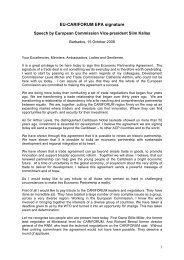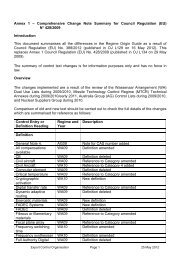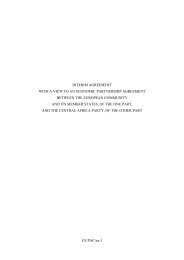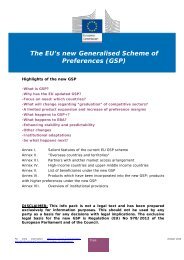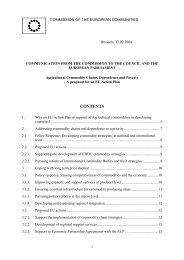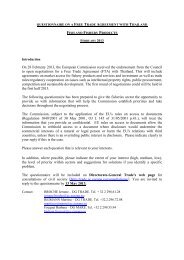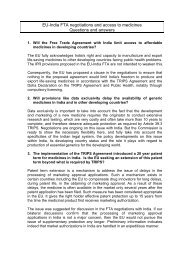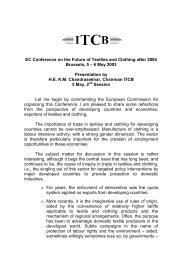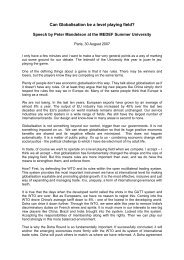Report on the Implementation of the derogation to ... - Trade Websites
Report on the Implementation of the derogation to ... - Trade Websites
Report on the Implementation of the derogation to ... - Trade Websites
You also want an ePaper? Increase the reach of your titles
YUMPU automatically turns print PDFs into web optimized ePapers that Google loves.
Final <str<strong>on</strong>g>Report</str<strong>on</strong>g><br />
RoO Derogati<strong>on</strong> under <strong>the</strong> PACP-IEPA<br />
6.4.1 Extra-EU<br />
Table 6.6 details extra-EU canned tuna import data for <strong>the</strong> last ten years (2001-10). 263 The extra-EU<br />
canned tuna import market must be unders<strong>to</strong>od in <strong>the</strong> c<strong>on</strong>text <strong>of</strong> a combinati<strong>on</strong> <strong>of</strong> low-cost sites <strong>of</strong><br />
producti<strong>on</strong> and tariff preferences. Duty free access <strong>to</strong> <strong>the</strong> EU under Cot<strong>on</strong>ou (and subsequent IEPAs)<br />
or <strong>the</strong> GSP+ scheme is not by itself enough <strong>to</strong>:<br />
1. boost exports – o<strong>the</strong>r fac<strong>to</strong>rs such as availability <strong>of</strong> (EU compliant) raw material supply and<br />
domestic political and/ or ec<strong>on</strong>omic dynamics and crises are also important c<strong>on</strong>siderati<strong>on</strong>s,<br />
as <strong>the</strong> declines <strong>of</strong> Guatemala, Cote d’Ivoire, Madagascar and Senegal illustrate (Table 6.6); or<br />
2. block low-cost, high-volume operati<strong>on</strong>s – as <strong>the</strong> c<strong>on</strong>tinued importance <strong>of</strong> Thailand and <strong>the</strong><br />
Philippines shows.<br />
The extra-EU canned tuna import market has become slightly more c<strong>on</strong>centrated am<strong>on</strong>g <strong>the</strong> <strong>to</strong>p-five<br />
supplying countries over <strong>the</strong> last decade. In 2001, <strong>the</strong> Top-five 264 provided 65% in volume; in 2010<br />
<strong>the</strong> Top-five 265 share had increased <strong>to</strong> 70%. Combined, <strong>the</strong> six African IEPA countries had a 53%<br />
market share in 2001 which had dropped <strong>to</strong> 39% in 2010 – a 14% relative decline (albeit <strong>of</strong> a growing<br />
absolute market) despite c<strong>on</strong>tinued duty-free access. This relative decline can largely be accounted<br />
for by a 15% increase in share over <strong>the</strong> same period by <strong>on</strong>ly three countries: Ecuador (from 8% <strong>to</strong><br />
17%), Thailand (from 15% <strong>to</strong> 18%), and <strong>the</strong> Philippines (from 9% <strong>to</strong> 12%).<br />
Excluding PNG and <strong>the</strong> Solom<strong>on</strong> Islands, <strong>the</strong> five Asia-Pacific countries in Table 6.6 exported a <strong>to</strong>tal<br />
volume <strong>of</strong> 127,933 mt <strong>of</strong> canned tuna in 2010, accounting for a 34% share <strong>of</strong> <strong>the</strong> EU market. This<br />
indicates that <strong>the</strong>se countries are competitive despite <strong>the</strong> standard GSP import tariff <strong>of</strong> 20.5% <strong>on</strong><br />
canned tuna. Thailand has c<strong>on</strong>sistently been a lead supplier since <strong>the</strong> 1980s and over <strong>the</strong> last ten<br />
year period has emerged as <strong>the</strong> extra-EU import market leader. In a similar upward trend, <strong>the</strong><br />
Philippines has g<strong>on</strong>e from 5 th <strong>to</strong> 3 rd positi<strong>on</strong>. The main emerging player in Sou<strong>the</strong>ast Asia is Vietnam,<br />
which has grown without a substantial domestic supply <strong>of</strong> tuna. However, raw material supply<br />
appears <strong>to</strong> be an increasingly important dynamic in limiting producti<strong>on</strong> in some Asian countries. The<br />
drop <strong>of</strong>f in Philippines exports in 2010 from a high point in 2008/9 was due primarily <strong>to</strong> insufficient<br />
supply <strong>of</strong> tuna.<br />
The decline in Ecuador’s exports in 2009 and 2010 after its rapid rise since 2001 is also explained by<br />
266<br />
fac<strong>to</strong>ries cutting producti<strong>on</strong> due <strong>to</strong> reduced supply <strong>of</strong> fish at a commercially competitive price.<br />
The origin <strong>of</strong> this issue is low catches/supply (i.e. processors based in Ecuador are producing below<br />
maximum capacity because <strong>of</strong> low supply and its associated upward impact <strong>on</strong> price).<br />
263 For more detail <strong>on</strong> extra-EU suppliers see Secti<strong>on</strong> 6.6.<br />
264 Seychelles, Thailand, Côte d’Ivoire, Ghana and Philippines.<br />
265 Thailand, Ecuador, Philippines, Mauritius and Seychelles.<br />
266 Hamilt<strong>on</strong> et al. 2011.<br />
Linpico s.a.r.l. Page 132




